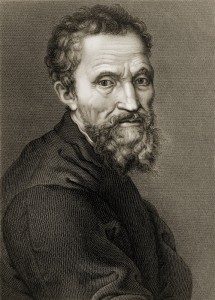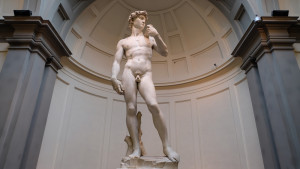 Michelangelo di Lodovico Buonarroti Simoni, who would become known to later generations as simply “Michelangelo,” was born in Caprese, Italy, on March 6, 1475. When he was still a baby, his family moved back to Florence, where his father was originally from. This move would influence Michelangelo’s interests and aspirations for the rest of his life. As a thriving center for the arts and intellectual life, Florence sparked Michelangelo’s interest in painting as a child. He was apprenticed to the painter Domenico Ghirlandaio at the age of 13, despite his father’s wishes that he study something more practical.
Michelangelo di Lodovico Buonarroti Simoni, who would become known to later generations as simply “Michelangelo,” was born in Caprese, Italy, on March 6, 1475. When he was still a baby, his family moved back to Florence, where his father was originally from. This move would influence Michelangelo’s interests and aspirations for the rest of his life. As a thriving center for the arts and intellectual life, Florence sparked Michelangelo’s interest in painting as a child. He was apprenticed to the painter Domenico Ghirlandaio at the age of 13, despite his father’s wishes that he study something more practical.
Michelangelo’s Big Break | Learning to Be Great
A short year later, Michelangelo got his big break. Lorenzo de Medici, one of the wealthiest and most powerful men in Florence, took an interest in the talented young artist, and invited Michelangelo to live in his palace. de Medici was a famous patron of the arts, and during his years at the palace, Michelangelo was able to study under some of the most famous luminaries of the day.
Michelangelo’s education at the de Medici home served him well, and as his fame as an artist grew, he received commissions for paintings and sculptures from some of the most famous and powerful men in the world. Despite his fame, though, Michelangelo’s personal life was sometimes troubled. He had an arrogant streak, and his perfectionism about his art led him to quarrel with the people he worked for. He also fell into depression at times. Michelangelo never married, and scholars still debate whether or not he may have been homosexual.
Michelangelo | A Man of Many Masterpieces
 Four of Michelangelo’s greatest masterpieces include the Sistine Chapel, the David, the Pieta, and St. Peter’s Basilica. All of these works of art and architecture can still be seen in Italy today. Three of them – St. Peter’s Basilica, the Pieta, and the Sistine Chapel – can be found in the Vatican City, the seat of the Catholic church. The David currently resides at the Galleria dell’Accademia in Florence, the city Michelangelo always regarded as his home.
Four of Michelangelo’s greatest masterpieces include the Sistine Chapel, the David, the Pieta, and St. Peter’s Basilica. All of these works of art and architecture can still be seen in Italy today. Three of them – St. Peter’s Basilica, the Pieta, and the Sistine Chapel – can be found in the Vatican City, the seat of the Catholic church. The David currently resides at the Galleria dell’Accademia in Florence, the city Michelangelo always regarded as his home.
Something most people don’t know is that Michelangelo almost declined the job of painting the Sistine Chapel, which arguably became his greatest masterpiece. In 1508, Pope Julius II asked Michelangelo to repaint the ceiling – which was, at the time, painted blue and dotted with gold stars – because it had been cracked by nearby construction work. Michelangelo argued that he was a sculptor, not a painter, and tried to decline the offer. The pope, however, pressed him to take the job, probably at the insistence of his chief architect, Bramante. Bramante was a longtime rival of Michelangelo’s, and he wanted to see the great sculptor fail at something. The scheme may have been an attempt to force Michelangelo out of Rome altogether. Obviously, though, the scheme didn’t work. Michelangelo accepted the job, spent the next four years painting the chapel’s ceiling, and created one of humankind’s most enduring artistic masterpieces in the process. So much for his assertion that he wasn’t a painter.
Michelangelo died in 1564 at the advanced age of 88, but his legacy still lives on today. He influenced many of the greatest painters of the Renaissance, including Raphael. His sensitive, nuanced portrayals of religious art, such as the Creation of Adam, affected the way many people thought about their faith and relationship with God, and his work still adorns the seat of the Catholic church. Today, millions of art enthusiasts and curious tourists visit Italy every year to see the works of the great master in person. Whether you’re an art lover, an Italian history buff, or just someone who likes to learn more about the world, you can do the same.

